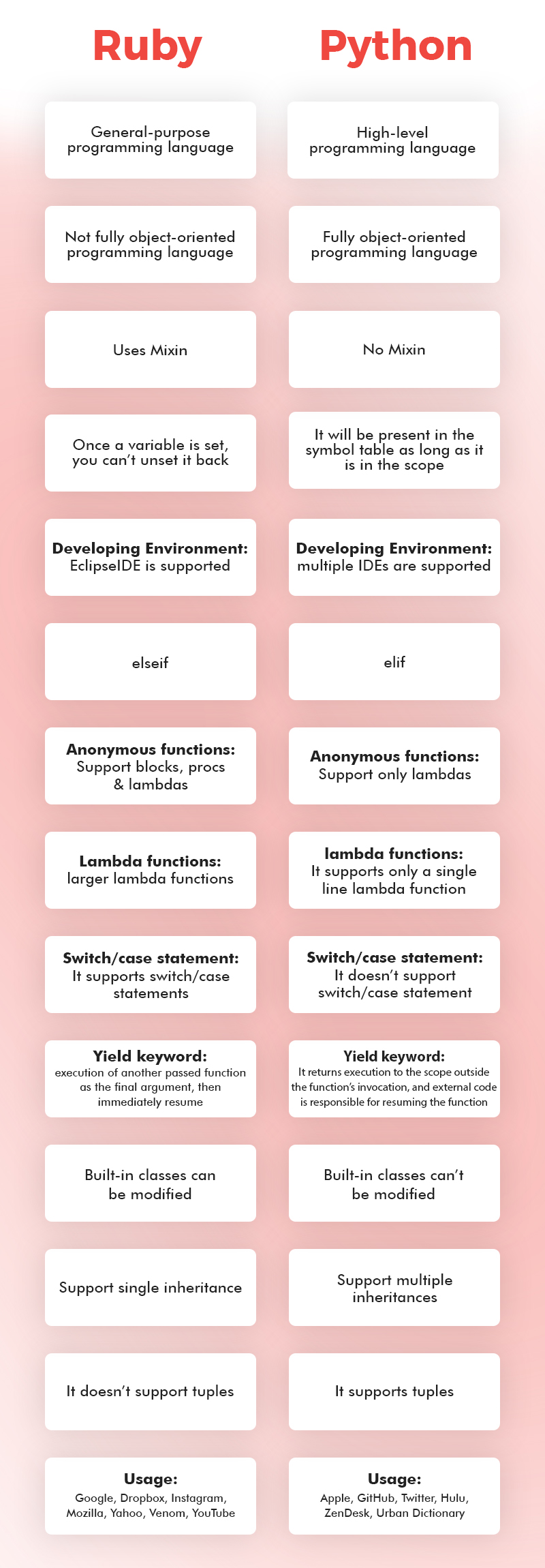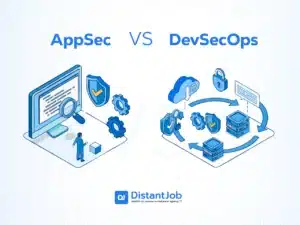Ruby vs Python is a never-ending battle. Airbnb uses Ruby, while Instagram prefers Python. Which is better, Ruby or Python?
Ruby’s inventor wanted to create a free and accessible language, and so did Python’s mastermind. To decide which one is the best one for your project, you start looking at job ads and find out which role has more offers. Typing on Stack Overflow’s search bar for remote jobs, however, doesn’t give you the full picture. You will find more results for Python than Ruby. Likewise, on LinkedIn, Python leads by 20% over Ruby. It appears that the Python skill set is in higher demand. On the other hand, Ruby developers have a better salary range and are harder to keep and retain because of competitive offers, according to PayScale in the U.S. market.
If you are a developer, it might be easier to learn how to write both languages. As a software developer, I have started my journey with Python, which is always been a loyal ally, and I approached Ruby later on in my career.
But what’s the best choice when it comes to hiring?
What Is Ruby?
Ruby is a programming language created by a Japanese programmer, Yukihiro “Matz” Matsumoto. He wanted to create a new language that balanced functional and imperative programming. Seeking elegance and simplicity, the creator blended bits of his favorite languages, such as Perl, Smalltalk, Eiffel, Ada, and Lisp.
Launched in 1995, Ruby reached mass acceptance in 2006. At the time, the primary mailing list Ruby-Talk peaked at an average of 200 messages per day. During the following years, different groups opened up to discuss Ruby. Shortly, groups of developers and programmers join forces forming communities like rubyonrails.com or Ruby Community to share knowledge and expand existing libraries.
Today, Ruby ranks among the top 10 most popular programming languages worldwide, mainly thanks to its unique web framework Ruby on Rails.
Benefits of Ruby
First, the software license is completely free of charge, as well as it’s free to use, copy, modify, and distribute. Besides free change and flexible features, Ruby offers many advantages for programmers and business owners.
1. Object-Based
“I wanted a scripting language that was more powerful than Perl, and more object-oriented than Python.” That’s what Matz said when he explored other programming languages to find the ideal syntax.
As a result, in Ruby, everything is an object. To clarify, any piece of information and line of code has its properties and actions. Technically speaking, with object-oriented programming, properties are called instance variables, and actions are methods. Unlike other languages, a pure object-oriented approach can apply an action to numbers or different primitive types, opening more opportunities for creation and web development.
2. Flexibility
As we mentioned earlier, Ruby is a flexible language because users can alter; add; remove; and copy its parts without restrictions. For example, to add performance to a running project, a programmer can write the plus (+) operator or simply the word plus. The same goes for numbers and other actions.
3. Blocks
Ruby’s blocks are one of the features of this coding language. Using these types of blocks, your programmer can attach a closure (block) to any method, clearly illustrating the course of action. You can insert a block into a do … end construct, leaving space to fill in additional details or new blocks.
4. Mixin
Unlike many object-oriented languages, Ruby’s peculiarity features a single inheritance relying on the concept of modules. Ruby’s classes can mixin a module while receiving other methods for free. As a result, Ruby’s writers can write complex and flexible code in a more explicit structure than multiple inheritances.
5. Visual Appearance
As we said, Ruby often uses limited punctuation, preferring English keywords. For these reasons, Ruby doesn’t need variable declarations, rather spoken words to denote the scope of variables. For example:
- var could be a local variable.
- @var is an instance variable.
- $var is a global variable.
As a result, programmers can quickly identify the roles of each variable.
Additional Ruby Implementations
Ruby has different implementations that can provide additional integrations to other languages or environments. Here’s a list of the most common ones:
- JRuby is Ruby atop the JVM (Java Virtual Machine), utilizing the JVM’s optimizing JIT compilers, garbage collectors, concurrent threads, tool ecosystem, and a vast collection of libraries.
- Rubinius is ‘Ruby written in Ruby’
- TruffleRuby is a high-performance Ruby implementation on top of GraalVM.
- mruby is a lightweight implementation of the Ruby language that can be linked and embedded within an application.
- IronRuby is an implementation “tightly integrated with the .NET Framework”.
- MagLev is “a fast, stable, Ruby implementation with integrated object persistence and distributed shared cache”
- Cardinal is a “Ruby compiler for Parrot Virtual Machine” (Perl 6).
What Is Python?
Released in 1991, Python is one of the most famous programming languages. Getting into the digital world, it’s almost impossible to never come across something written with this language – 90% of developers you will interview probably moved their first steps with Python.
In 1989, a Dutch programmer, Guido van Rossum, developed this coding language for any skill level. Inspired by British comedian Monty Python, the language has a straightforward structure to create very complex projects. Lacking curly quotes or semicolons to forget at the end of most lines, Python works as scripting, compiled code, and embedded code. Like Ruby, a vast community shares knowledge encouraging documentation of code solutions.
Benefits of Python
1. Flexibility
Once again, flexibility is one of the top benefits to consider. Python’s flexibility is the result of many updates and evolutions. Python can run a web application, a standalone application using third-party tools, or a supportive application incorporated into a more extensive software system. Because of its multiple uses, this language is an efficient tool in a broader range of situations than other languages. This flexibility makes the language an option in a wider range of conditions than other languages. Python also works for functional, object-oriented, and imperative coding styles.
2. Libraries & Open Sources
Programmers writing in Python can rely on vast libraries to access functionality and tips. The Python standard library includes internet protocols, string operations, web services tools, and operating system interfaces. By accessing these libraries, programmers can share their knowledge and ask for information and solutions. In addition, the Python language is developed under an OSI-approved open source license. Like Ruby, Python is free to use and distribute for everyone.
3. User-friendly
Aiming to be easy, Python offers excellent readability and easy syntax, which makes this language adapt for both beginners and programmers. PEP 8, the code style guidelines, gives a set of rules to format the code easily. In addition, Python includes a built-in list and dictionary data structures to construct fast runtime data structures. Further, Python provides the option of dynamic high-level data typing, which, for programmers, reduces the length of support of needed code.
4. Prototypes
As we just said, Python is easy to learn. In addition, because of its flexible structure, it is easy to develop and adjust. When you are running a startup and you are building a prototype, Python is a valuable option to consider. So, a developer can build prototypes and test out outputs quicker and more efficiently than with other languages. Launching new projects, using Python speeds up the development process and reduces the impact on your company budget.
5. Productivity
Last but not least, Python helps with productivity. First, it’s open-source with extensive access to libraries and databases that help your developer. Second, the integration features, unit testing framework, and control capabilities speed up applications’ productivity. For these reasons, Python is one of the most efficient options when building scalable multi-protocol network applications.
Ruby vs Python In Web Development
To recap, both Ruby and Python are great languages to use in web development.
As we mentioned, Ruby’s web framework is Ruby on Rails (2003), which uses a Model-View-Controller (MVC) architecture. This type of architecture is a conventional method to separate logic. The Model indicates where data is stored and processed. The View shows the interface and displays the data to the user. Finally, the Controller runs the process when the user requests data in the View and uses the Model to send a response.
Headed by Basecamp, Ruby on Rails allows faster project development. Companies such as Twitter, Airbnb, Github, and Shopify are currently using Ruby on Rails. According to the StackOverflow annual survey, only 7.1% of developers work with Ruby on Rails, compared to 67.7% with Java and 44.1% with Python. Even if Ruby the 11th most loved web framework, Ruby on Rails developers are harder to find nowadays. For this reason, startups and companies tend to avoid launching new projects with this technology.
Python’s web framework is Django (2005). It also uses an MVC architecture, but with a small difference. Django uses a Model-View-Template (MVT) architecture. This type of web architecture is very similar to MVC architecture. Besides, it also takes care of routing. The Template allows complete handling of user interfaces. View executes the business logic, interacting with the model and rendering the template.
Supported by Django Software Foundation, Django is an open-source project. This web framework is very popular because of its dynamic and accessible architecture. Websites like Instagram, Spotify, Youtube, and BitBucket use Django because it provides different solutions and uses. For example, using the Django Rest framework, the framework can be used as an API and a JavaScript front-end framework.
Ruby vs Python Comparison
Both languages provide solid and efficient frameworks for web development, speeding up development processes and offering a clean design. Because of their flexibility, they can work on multiple platforms keeping a clean syntax and high readability.
In short, these two languages are similar in their efficiency and flexibility. But what about their differences?
Ruby vs Python: Differences

What To Consider When Hiring A Ruby Programmer?
Besides Ruby’s benefits, what to consider when hiring? A Ruby developer is a backend software developer. The main job is creating databases, libraries, and the logic that makes up a web application. Generally speaking, a Ruby developer needs experience with Ruby on Rails and other programming frameworks and languages and experience in handling and developing APIs.
When looking for a Ruby developer, you want to hire someone responsible for building dynamic website applications with Ruby on Rails and for designing and developing these web applications with the rest of the team.
Ruby Developer’s Responsibilities
- Design, build, and maintain efficient and reusable Ruby code
- Integrated data storage solutions
- Create compatibility with user-facing elements developed by front-end developers with server-side logic
- Identify and locate issues with bottlenecks and bugs with creative problem solving
- Help to maintain code quality, organization, and automatization
Ruby Developer’s Skills
Hiring a Ruby developer, you should always seek proficiency with JavaScript, HTML5, and CSS3. As we said, Ruby is an object-oriented programming language requiring automated testing procedures. Besides learning new trends, your future developer will collaborate with other team members. So, teamwork, reliability, and excellent written and spoken communication skills are fundamental requirements.
Based on the scale of your project and the level of expertise you need, here are the core skills based on years of experience:
Entry-level Ruby Developer Skills (0 To 2 Years)
- Knowledge of Ruby framework to fix bugs, write code without supervision, and provide solutions.
- Familiarity with HTTP protocol, such as protocol structure and types of nodes.
- Understanding MVC, ActiveRecord, assets, deployment Rails-application on Heroku.
- Basic knowledge of other programming languages and Linux.
- Redis, Sidekiq, HAML/SLIM and AWS infrastructure knowledge.
Mid-level Ruby Developer Skills (3 To 6 Years)
- Create software performing any type of coding task without supervision.
- Strong knowledge of standard Ruby library.
- Conduct comparative analysis of gems/code from public repositories to pick the best option for the running project.
- Advanced unit-testing, feature-testing, mocking web services and 3rd-party APIs.
- Use automated linters, style checkers, static code analyzers.
- Design patterns and AWS.
Senior Ruby Developer (6+ Years)
- Metaprogramming skills and advanced concurrent programming.
- TLS architecture and DNs protocol construction.
- Code style checkers integration and static analyzers.
- Deep knowledge of AWS to create flexible architecture.
- Productivity and speed optimization of HTTP, SPDY, HTTP/2 on each stage of data exchange.
- Familiarity with libraries/frameworks/architecture solutions, such as ROM, Hanami, dry-rb, RabbitMQ.
- Customize library behavior contributing to it.
- Team management skills.
What To Consider When Hiring A Python Programmer?
A Python developer works with data collection and analytics, usually handling tasks like web development, scripting, web scraping, data analysis, and automation. In addition, a python developer designs frameworks for new code, builds new tools, publishes new services, and creates new website features.
As we mentioned earlier, Python is an easy language to build scripts for beginners and senior programmers. Based on the years of experience, here is what you want to look at when hiring a Python developer.
Python Developer’s Responsibilities
- Write effective, reusable, and scalable Python codes
- Integrate user-facing elements from front-end developers in the server-side logic
- Structure implementation and design solid applications
- Debug applications ensuring low-latency and high-availability
- Integrate user-facing elements with server-side logic
- Security and data protection implementation
- Find data storage solutions
Python Developer’s Skills
As we mentioned earlier, Python is easy to learn and it’s accessible to beginners and senior developers alike. Regardless of the level of expertise you are hiring, a Python developer needs familiarity with Python language and ORM (Object Relational Mapper) libraries. Since the developer will handle data sources and databases, it’s necessary an understanding of Python threading limitations and multi-process architecture. Finally, a basic understanding of front-end technologies, such as JavaScript, HTML5, and CSS3, and other coding languages for side templates.
Here is a list of skills and requirements based on years of experience and expertise:
Entry-level Python Developer Skills (0 To 2 Years)
- General Python syntax
- Data structures
- Basic knowledge of SQL
- Basic CVS skills
- Experience with any popular web framework
- Ability to make a simple app from scratch
Mid-level Python Developer Skills (3 To 6 Years)
- Solid knowledge of object-oriented design, coding, and test patterns
- Experience with building Big Data solutions and software development experience in Python
- Building and maintaining software platforms (commercial or open-source)
- Exposure to a cloud computing service such as an AWS is an added advantage
Senior Python Developer (6+ Years)
- Proficiency in writing complex logic in Python (industry standards)
- Knowledge of front-end technologies such as JavaScript, HTML5, and CSS3
- Familiarity of object-relational mapper (ORM)libraries
- Experience in data visualization tools such as Tableau and Qlik and Query languages like SAS, SQL, and Hive
- Exposure to AWS or other cloud computing services
- Knowledge of Big Data technology such as HDFS, Pig, Hive, Spark, and Scala
- Substantial unit test and debugging skills and understanding of threading limitations of Python
Python vs. Ruby – Which to Use For Your Web Development Project
Both languages have advantages and disadvantages. According to StackOverflow, Ruby on Rails won over Django right in the beginning. Ruby’s popularity is more related to existing projects, and for new applications, most businesses tend to use other languages.
If you are looking for an ongoing project with Ruby, it’s best to hire a Ruby developer rather than switching coding languages. On the other hand, if you launch a new project, it’s best to hire a Python developer. More developers specialize in this system, and you can choose different levels of expertise based on your project.
However, going remote with DistantJob solves your problem. There are countries around the globe with highly professional Ruby developers ready to start new projects with brilliant and creative virtual teams. The same goes for Python. And if you have no idea where to begin your research, don’t worry! Just knock on our virtual doors. We know where to look and how to hire talented remote developers for your team!





